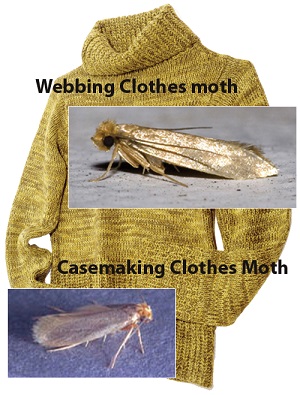Clothing Moth Treatment in Mercer, Ocean, Monmouth, Somerset, & Middlesex County
We specialize in the removal of clothing moths
 Two common types of moths, the Casemaking Clothes Moth and the Webbing Clothes Moth, are known for damaging clothing and fabrics. While distinguishing between them isn't crucial for treatment, understanding your pest is beneficial.
Two common types of moths, the Casemaking Clothes Moth and the Webbing Clothes Moth, are known for damaging clothing and fabrics. While distinguishing between them isn't crucial for treatment, understanding your pest is beneficial.
At Cowleys Pest Services, we specialize in eliminating all types of clothing moths across Mercer, Ocean, Monmouth, Somerset, and Middlesex County. If you're dealing with moth damage to your clothing or fabrics, reach out to us today for expert assistance in safeguarding your belongings.
Casemaking Clothes Moth (Tinea pellionella)
The Casemaking Clothes Moth earns its name from the silken case spun by its larvae. Adults are tan to light brown and can reach up to half an inch in length, often displaying three darker spots on their wings. The larvae, carrying their protective casing, move as a single unit.
Thriving in warmer climates, these moths adapt well to heated indoor environments. Females may deposit up to 85 eggs on natural materials like wool, though they also feed on plant-based items such as herbs and natural fibers like rope. Development from egg to adult spans six to fifteen weeks, during which larvae consume and drag their casing across food sources.
Infested materials exhibit signs of fibers being scraped away, resembling a threadbare appearance. If you suspect a Casemaking Clothes Moth infestation, prompt action is key to preserving your belongings.
Webbing Clothes Moth (Tinea bisselliella)
The Webbing Clothes Moth is the most common clothes moth found domestically. Adults appear similar to Casemaking Clothes Moths but have no spots on the wings. Webbing clothes moth adults also have a tuft of red hair on the top of the head. While most homeowners will never be this close to an adult moth to compare hairs, if ?specimens are found, you might be able to see the red hairs.
The Webbing Clothes Moth spins a web that can appear to be a flat silken small mat. The moth larvae feed on materials of animal origin including furs, woolens, feathers, and even in food products such as ?dried milk.
The total life cycle can take from as little as a month to several years depending on the food source and conditions. This pest is most devastating to furs as they will cut off the hairs of the fur at the hide level leaving “blotches” or patches of missing fur. This type of pest is the reason that many furs are held in storage in the off-season.
How to control Clothes Moths
If you notice suspicious holes or webbing in your fabrics, don't hesitate to reach out for a thorough inspection. Our trained professionals will carefully assess your closets, storage areas, and fabrics to determine if an infestation is present. If confirmed, we'll pinpoint the source and implement targeted treatments, minimizing disruption and providing peace of mind as we safeguard your valuable natural fibers.
Call or contact us online today for a free estimate on Clothes Moths removal and other pest removal services. We proudly service the areas of Somerset, Edison, Lakewood, Toms River, Brick, Bridgewater, Piscataway, Old Bridge, Middletown, Princeton Junction, and nearby!
Looking for a price? Get a no cost, no obligation free estimate.